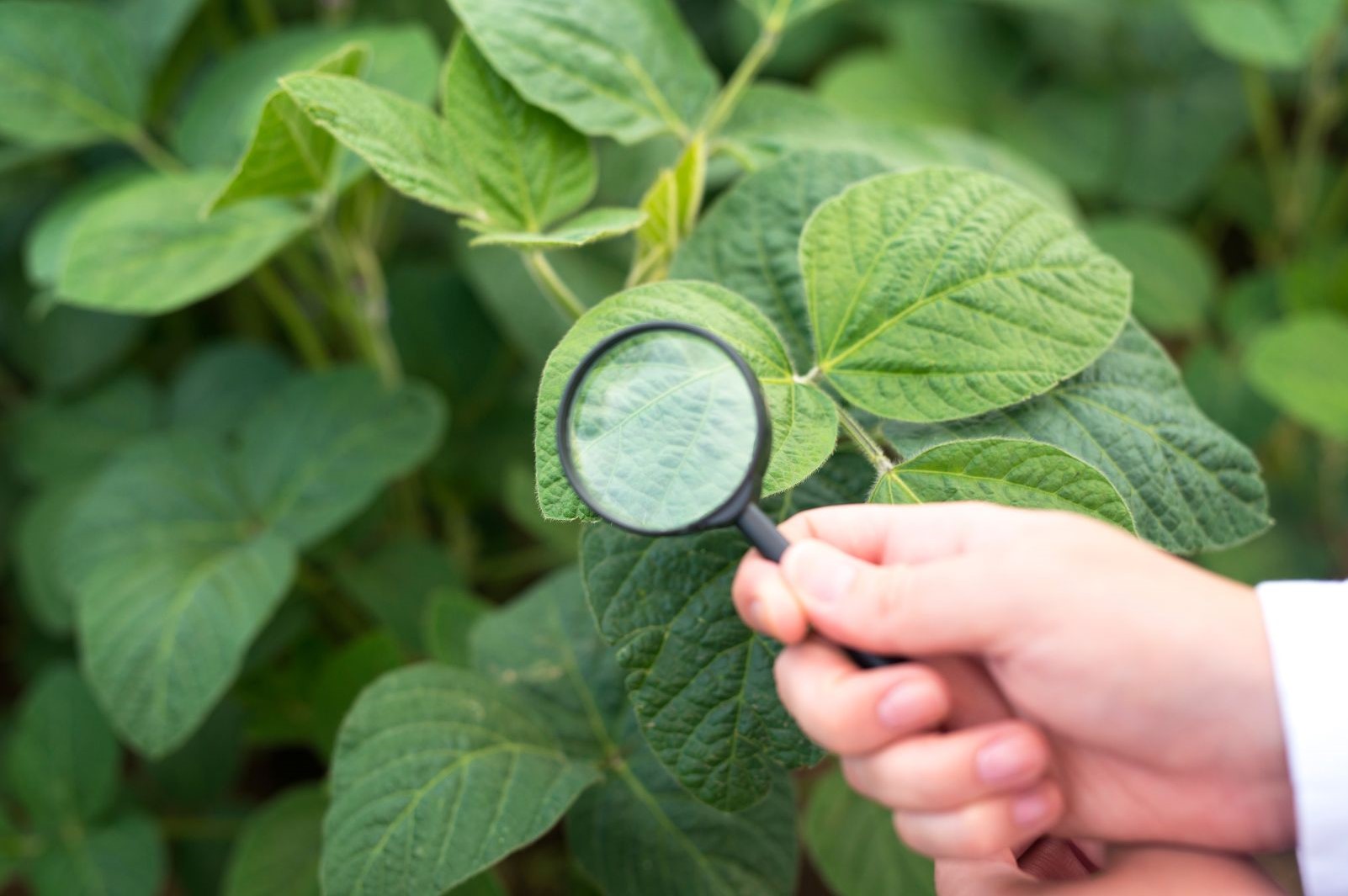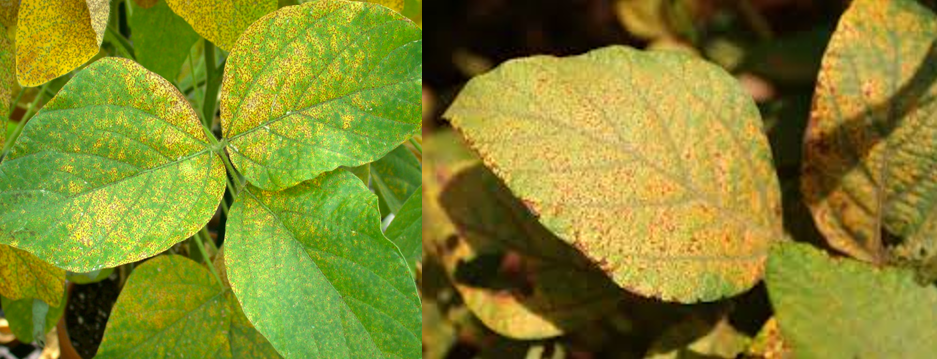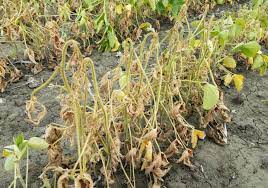Soybean Diseases and Management Practice

This post is also available in:
This post is also available in:
![]() हिन्दी (Hindi)
हिन्दी (Hindi)
Which are the most important diseases in soybean, and how to control them efficiently
Phytophthora Root and Stem Rot – Phytophthora sojae
Pathogen:
Phytophthora sojae is a soil-borne fungus that can cause significant damage to soybean plants.
Favorable weather conditions for Phytophthora Root and Stem Rot development
● Moderate temperatures: Phytophthora sojae prefers moderate temperatures ranging from 20°C to 30°C (68°F to 86°F).
● Phytophthora sojae thrives in saturated or waterlogged soil conditions. Prolonged periods of rainfall or over-irrigation can create a conducive environment for the pathogen to infect soybean plants.
● High humidity levels, particularly during warm weather, promote the growth and spread of Phytophthora sojae.

Symptoms of Phytophthora Root and Stem Rot in Soybean plants
● Before or after emergence, seeds may rot, and seedlings may die, a condition known as damping-off.
● During the mid-to late-season, one of the symptoms is the presence of a chocolate-brown stem lesion that extends up from the soil line.
● There is a possibility for the development of leaf chlorosis, necrosis, and plant wilting
● The frequent occurrence of this phenomenon is often seen in patches of fields and low-lying areas.
Management Recommendations of Phytophthora Root and Stem Rot in Soybean plants
● Crop rotation: Avoid consecutive soybean plantings in the same field.
● The protection of young plants is achieved through fungicide seed treatments.
● One effective strategy in managing Phytophthora is to plant soybean varieties with genetic resistance, also known as resistant cultivars.
● To minimize disease development, it is essential to improve soil drainage, as waterlogged conditions promote favorable environments for the disease.
Soybean Rust – Phakopsora pachyrhizi
Pathogen:
Phakopsora pachyrhizi is a fungus that causes soybean rust, a devastating disease of soybean plants. Soybean rust is a significant concern for soybean farmers worldwide as it can cause substantial yield losses if left unmanaged.
Favorable weather conditions for Soybean Rust development
● The development and spread of soybean rust are influenced by specific weather conditions. Moderate temperatures ranging from 20°C to 30°C (68°F to 86°F)
● High humidity (greater than 75%) promote the germination of spores and disease progression.
● Extended periods of leaf wetness, such as dew or rainfall, are also conducive to infection and disease development.
Symptoms of Soybean Rust
● On the leaves, you may observe very small spots that are gray-green, tan, and/or red-brown.
● Underneath the leaf, small pustules are present, requiring the use of a hand lens to be seen.
● It is also possible to observe leaf chlorosis and defoliation.
Note: This condition often presents similarities (symptoms) that look like bacterial pustules and other foliar diseases, causing confusion during diagnosis.
Recommendations – How to control Soybean Rust
● To reduce the impact of soybean rust, choose varieties resistant or tolerant to the disease.
● When rust is observed in the field or under high-risk conditions, using fungicides in a timely manner can help manage the disease. Consult local experts, adhere to regional recommendations, and choose suitable fungicides with proper application timings.
● Regularly monitoring soybean fields for rust symptoms, like yellow-orange pustules on the undersides of leaves, enables early detection and facilitates prompt intervention and control measures.
● Ensure healthy plant growth by optimizing plant nutrition, spacing, and irrigation practices. Healthy plants have enhanced abilities to withstand rust infections and can recover more effectively.
Wilt – Fusarium oxysporum f. sp. tracheiphilum
Pathogen:
Fusarium oxysporum f. sp. tracheiphilum is a fungal pathogen that causes Fusarium wilt in various crops.
Favorable weather conditions for disease development
● Fusarium wilt is favored by warm soil temperatures ranging from 24°C to 29°C (75°F to 85°F).
● High soil moisture levels, poor drainage, and sandy soils can also contribute to disease development.
● The pathogen can persist and survive in soil under unfavorable conditions for extended periods.
Symptoms of wilt disease in Soyabean
● Initially, symptoms do not appear until the plants are about six weeks old. Pale green flaccid leaves are noticed in a few plants, which soon turn yellow.
● Growth is stunted, accompanied by chlorosis, drooping, premature shedding, or withering of leaves. Veinal necrosis often occurs; ultimately, the plant dies within 5 days.
Control measures for wilt in Soyabean
● To ensure optimal results, farmers are advised to plant good-quality seeds with a high germination rate.
● Treat soybean seeds with fungicides or biological agents to control Fusarium wilt. This can help protect the seeds from initial infection and promote healthy seedling development.
● Practice good sanitation measures, such as removing and destroying infected plant debris, to prevent the spread of the disease within and between fields.
● Regularly monitor soybean fields for signs and symptoms of Fusarium wilt. Early detection allows for timely management actions and minimizes the disease’s impact.
Sudden Death Syndrome in Soybean – Fusarium virguliforme
Pathogen:
Fusarium virguliforme is a soilborne fungal pathogen that causes Soybean sudden death syndrome (SDS).
Favorable weather conditions for disease development
● Soybean sudden death syndrome is favored by cool and wet conditions during early soybean growth stages.
● Soil temperatures ranging from 15°C to 25°C (59°F to 77°F) and excessive soil moisture contribute to disease development.
Symptoms of Sudden Death Syndrome in Soybean
● There is yellow and brown discoloration between leaf veins
● While the pith remains white, a tan stem can be found under the epidermis near the soil line.
● Leaflets can fall while petioles remain attached to the plant.
Control measures for Sudden Death Syndrome in Soybean
● Use less susceptible plant varieties.
● Provide good field drainage and reduce soil compaction.
● To ensure optimal conditions, it is recommended to delay planting until soils are warm and dry.
● Consider the seed treatment method.
Soyabean Leaf spot – Cercospora sojana
Pathogen:
Cercospora sojina (formerly known as Cercospora kikuchii) is indeed a fungal pathogen that causes a leaf spot disease on soybean plants.
Favorable weather conditions for disease development
● Cercospora leaf spot thrives under warm and humid conditions. Optimal temperature ranges for disease development are around 25-30°C (77-86°F).
● Extended periods of leaf wetness or high relative humidity promote spore germination and infection.
Symptoms of Soyabean Leaf spot
● The initial stage of the lesion are dark spots that vary in size
● The center of the lesions becomes tan to gray and is surrounded by a reddish-brown to purple ring.
● In lesion centers, fuzzy gray mold may occur.
● Spots may coalesce, causing large portions of leaves to fall out and die.
Control Recommendations of Soyabean Leaf spot
● Rotate the soybean crop with cereals.
● Clean and plow the field soon after harvest to completely remove plant residue.
● Destroy infected stubble from last year.
● Use healthy-certified seeds.
Powdery Mildew in soybean plants – Erysiphe diffusa
Pathogen:
It is a fungal pathogen that affects various plant species.
Favorable weather conditions for disease development
● Powdery mildew thrives in moderate temperatures and high humidity.
● The disease develops best under dry conditions on the plant surface but with high humidity in the surrounding air.
● Overcrowded plantings, poor air circulation, and dense canopies can create favorable conditions for disease development.
Symptoms of Powdery Mildew in soybean
● Powdery white tufts of fungal growth can be observed on the upper side of the leaf
● The fungal growth on the leaves may resemble white flour sprinkled on them and can be easily rubbed off with the hand.
● Small black specks may be observed in the growth late in the season.
Control Recommendations for Powdery Mildew in Soybean
● Rotate soybeans with non-host crops to disrupt the disease cycle and reduce pathogen buildup in the soil.
● Maintain adequate spacing between soybean plants as the disease thrives in crowded conditions to ensure good air circulation and prevent powdery mildew.
● Apply fungicides labeled explicitly for powdery mildew control following the recommended timings and rates. Consult local agricultural extension services for appropriate fungicide recommendations.
● To prevent powdery mildew development, avoid excessive irrigation or overhead watering, which can create favorable conditions. Opt for drip irrigation or other methods that minimize leaf wetness.
Soybean Cyst Nematode – Heterodera glycines
Pathogen information:
Heterodera glycines, commonly known as soybean cyst nematode (SCN), is a microscopic roundworm that is one of the most destructive pests of soybean crops worldwide.
Favorable weather conditions for SCN infestation and developement
SCN can spread through soil movement, water, equipment, and infected plant material. The cysts are durable and can survive in the soil for many years, even in the absence of soybean hosts. The nematode can also be spread through the movement of infested soil or equipment between fields.
Symptoms of Soybean Cyst Nematode Infestation
● Small, lemon-shaped female worms (cysts) are found on roots.
● The color of the cysts ranges from cream to dark brown.
● Often, there are no above-ground symptoms.
● Infested soybean plants can become stunted and yellow.
Recommendations – How to manage Soybean Cyst Nematode
● To identify problem fields and determine the extent and severity of the problem, employ a soil sampling program.
● Cultivate resistant varieties and, if possible, rotate sources of genetic resistance to SCN.
● Apply crop rotation with non-host crops.
● To avoid spreading SCN from infested to uninfested fields, work on uninfested fields first before moving the equipment to infested fields.
Further reading
Soybean Diseases and Management Practice
Soybean Pests and their Management Practices
Soybean Seed Treatment and its Uses
Soybean Pre-Planting Practices: Soil Preparation and Planting Dates and Distances
References :
- https://www.ndsu.edu/agriculture/sites/default/files/2022-07/pp1867.pdf
- https://mosoy.org/wp-content/uploads/2021/03/59934-21-MO-Disease-Guide.pdf
- https://www.iita.org/wp-content/uploads/2017/08/Soybean-Disease-Diagnostic-Guide_0.pdf
- https://www.uaex.uada.edu/publications/pdf/mp197/chapter11.pdf
- http://www.eagri.org/eagri50/PATH272/lecture18/lec07.pdf
- https://extension.missouri.edu/media/wysiwyg/Extensiondata/Pub/pdf/agguides/pests/ipm1002.pdf
- http://www.eagri.org/eagri50/PATH272/lecture18/lec07.pdf















































































